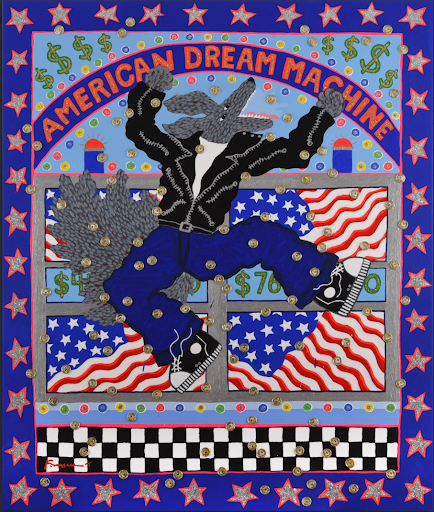Overview
Imagining the Native American Native California Artists Harry Fonseca (Nisenan Maidu)

Author: Frank Tuttle, (Yuki/Concow Maidu) Artist, Educator, and Ceremonial Leader
Contributor: Maggie Peters (Yurok and Karuk), Native American Studies Model Curriculum Learning Specialist Humboldt County Office of Education
Grades: 5-8
Suggested Amount of Time: 90 minutes or two 45 minute sessions
Curriculum Themes
- History
- Cultural Strengths
- Relationship to Place
Learning Goals
Explore how artists use their artworks as conduits to share cultural backgrounds, insights, and in Harry Fonseca’s case, historical tragedies impacting his tribe.
Examine the impact of the Gold Rush through the artwork of Harry Fonseca.
Identify Coyote as a Native Californian trickster figure and his role in traditional storytelling and modern society.
Lesson Overview
In this lesson, students will explore the life and artwork of Harry Fonseca, a celebrated Native California artist of Nisenan Maidu, Hawaiian, and Portuguese ancestry and a citizen of the Shingle Springs Band of Miwok Indians. Fonseca used his art to express identity, honor Native traditions, and respond to historical events like the California Gold Rush. Through vibrant paintings, symbolic imagery, and recurring figures like the trickster Coyote, Fonseca’s work invites students to think deeply about storytelling, cultural resilience, and how art can be both personal and political.
The lesson is designed to be interactive and accessible, using visuals, student handouts, and guided questions to support engagement. Students will learn about cultural elements like regalia, roundhouses, and petroglyphs, and reflect on how creation stories and historical memory influence artistic expression. They’ll also consider how Fonseca’s paintings preserve Native perspectives and challenge mainstream narratives of California history. By connecting art to identity and resistance, this lesson encourages students to reflect on their own stories and the power of creativity in shaping how history is remembered.
Teacher Background
Teaching Native American art, culture, and the impacts of colonization and genocide requires sensitivity, accuracy, and a commitment to centering Native voices. One of the most important best practices is to use materials created by Native people themselves, such as primary sources, artwork, and oral histories. This ensures that students are learning from authentic perspectives and not filtered or generalized accounts. It is also critical to teach students that Native American cultures are diverse and still thriving today; there is no single “Native” experience, and California alone is home to over 109 federally recognized tribes, each with distinct traditions, languages, and histories. When discussing difficult topics like genocide and the violence of the Gold Rush, teachers should be honest and thoughtful focusing on historical truth while also uplifting stories of Native resilience and cultural survival.
Using the paintings of Harry Fonseca allows students to explore how Native artists express identity, resist erasure, and keep stories alive through color, symbolism, and creativity. Teachers should avoid cultural appropriation and steer away from having students make regalia or sacred symbols, unless guided directly by Native educators. Instead, classrooms should focus on interpretation, appreciation, and inquiry. Finally, it’s essential to connect the past to the present by highlighting the work of contemporary Native artists, leaders, and movements. Whenever possible, educators should collaborate with local tribes, Native cultural centers and organizations to ensure teaching is respectful and accurate. These practices help create a more inclusive and meaningful learning environment where all students can explore Native history and culture with curiosity, respect, and empathy.

